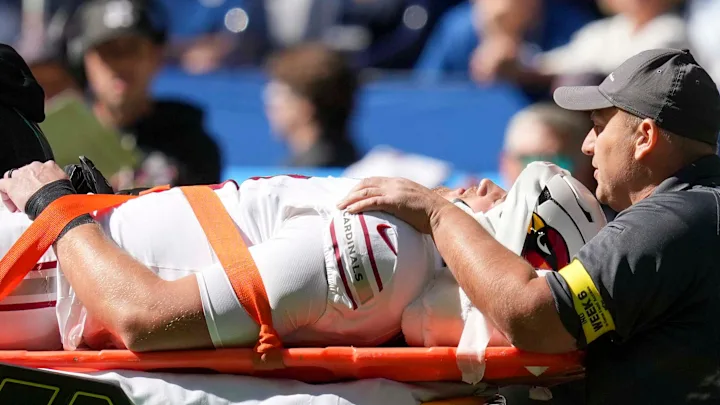Breaking: Cardinals’ Travis Vokolek Suffers Neck Injury During Clash with Colts

On Sunday afternoon in Indianapolis, a frightening moment overshadowed what had otherwise been a hard-fought battle on the gridiron: Arizona Cardinals tight end Travis Vokolek suffered a neck injury during a kickoff return against the Indianapolis Colts, forcing medical personnel to immobilize him, strap him to a stretcher, and cart him off the field.
The Scene: What Happened on the Play
The injury occurred roughly 11 minutes into the first quarter, on a Cardinals’ kickoff return attempt. Vokolek was engaged in blocking duties when he made contact with Colts linebacker Segun Olubi, after which he landed awkwardly and remained motionless on the turf.
Immediately, medical staff rushed onto the field. Observers noted that Vokolek lay flat on his back for several moments, without apparent movement, prompting serious concern among teammates, broadcasters, and fans alike. In an abundance of caution, the trainers stabilized his head and neck, affixed him to a backboard, strapped down his arms, and loaded him onto a cart to remove him from the field. During the cart ride through the tunnel, Vokolek was seen giving a thumbs-up, a somewhat reassuring gesture amid the severity of the situation.
Once removed from the field, he was ruled out for the remainder of the game. He was transported to a nearby hospital for further evaluation, though he was later released and met up with the Cardinals before their flight back to Phoenix.
Immediate Medical Status & Reassurances
Though the visuals of the injury were alarming, early reports offered some relief: Vokolek was noted to be alert and capable of moving his extremities, a positive sign in a potentially serious neck injury. Reporters on site mentioned he moved his hands during the stretcher extraction, and the thumbs-up during transport further suggested consciousness.
However, medical staff and the Cardinals organization were cautious in characterizing the injury, emphasizing that further imaging and tests would be needed to ascertain the full extent and prognosis. The hope, as reported, was that the injury would not be season-ending, but at the moment uncertainty loomed. Meanwhile, the team has ruled him out of further participation in the game.
Context: Who Is Travis Vokolek?
Travis Vokolek, 27, is a younger player in the NFL landscape, hailing from Nebraska and Rutgers during his collegiate career. He entered the league as an undrafted free agent in 2023 with the Baltimore Ravens before joining the Cardinals’ active roster later that same year.
In his tenure with Arizona, Vokolek has primarily served as a special teams contributor rather than a featured offensive weapon. To date, he has not recorded a catch, instead making his mark through blocking and coverage duties on kick units. In the 2025 season, he had appeared in four of the Cardinals’ first five games prior to the injury.
His role, though not glamorous, had become more significant in the wake of injuries elsewhere in the tight end room. With another tight end (Tip Reimann) already sidelined, Vokolek was projected to take on more responsibility, particularly in run-blocking and fourth-down situations.
From all accounts, he was well regarded in the locker room for his work ethic, willingness to fight for roster spots, and contributions on special teams. His sudden absence will almost certainly be felt.
Impact on the Cardinals — Strategically & Emotionally
Upset to the Tight End Room
Losing Vokolek unexpectedly gives the Cardinals one more complication in an already challenging tight end corps. With limited depth, Arizona now must rely more heavily on players like Trey McBride and Elijah Higgins to absorb extra snap share and blocking responsibilities. The Cardinals coaching staff, including head coach Jonathan Gannon, publicly expressed confidence in the remaining players to “pick up the slack.”
A Blow to Special Teams
Because Vokolek’s primary value was often on special teams units (covering kicks, blocking on returns, etc.), the Cardinals now lose a dependable contributor in an area where consistency and chemistry matter. New or younger players may be thrust into roles they’re less comfortable with, possibly leading to lapses or inefficiencies. Though not always glamorous, special teams play can swing field position, momentum, and ultimately game outcomes.
Emotional & Psychological Fallout
Injuries of this nature are sobering reminders of the physical toll inherent to football. For teammates and coaches alike, seeing a player carted off with a neck injury can stir anxiety, concern, and distraction. The emotional weight of such an event can linger beyond the game itself, affecting mindset, preparation, and morale. The Cardinals will need to manage not just the physical absence of Vokolek but the emotional ripple effects through the locker room.
On-Field Ripples & Playcalling Adjustments
From a schematic standpoint, the coaching staff may need to adjust blocking schemes in both the run and pass game, altering expectations for adjacent positions. If smaller or less-experienced tight ends are used more, the offense might have to adjust to compensate — e.g. increasing reliance on fullbacks, shifting formations, or minimizing designed plays that demand heavy inline blocking. The margin for error shrinks when you lose a dependable blocker.
Comparisons, Historical Perspective & Safety in the NFL
Neck and spinal injuries in football are among the most worrisome due to their potential for long-term consequences. Over the years, high-profile injuries have led the NFL, teams, and players’ associations to enhance protocols, equipment, and medical readiness on the sidelines.
This incident recalls several past scares in which players were immobilized on the field, such as incidents involving spinal alignment precautions during collisions. In many of those past occurrences, the difference between a manageable recovery and a career-ending (or worse) outcome often boiled down to immediate medical response, immobilization, and adherence to safety protocols. The NFL’s current medical standards, including baseline imaging, concussion protocols, and spinal injury procedures, are designed to reduce risk and improve outcomes.
In Vokolek’s case, the swift response—stabilizing his head and neck, securing him to a backboard, and safely transporting him off the field—reflects those modern standards in action. Whether those measures are enough depends on what further imaging reveals.
What’s Next — Recovery Timeline & Outlook
At present, definitive information about Vokolek’s prognosis is limited. The Cardinals and medical staff will likely proceed with imaging (MRI, CT scan), neurological evaluation, and perhaps consultation with spinal specialists to determine the severity — whether the injury involves soft tissue, vertebrae, ligaments, or even more profound spinal damage. News outlets have indicated that the hope is that it is not a season-ending injury, but no guarantees exist at this time.
Should diagnostics show only soft-tissue or mild structural damage, recovery might range from weeks to a few months — depending on severity, rehabilitation progress, and absence of secondary complications. However, if the injury involves more serious spinal structures, vertebral misalignment, or nerve involvement, the recovery could be much longer, perhaps involving surgical intervention or long-term rehabilitation.
In such cases, players often follow a graduated protocol: immobilization, rest, controlled physical therapy, strength and conditioning under supervision, and finally clearance (or denial) to return to contact. The Cardinals’ medical team and Vokolek’s personal specialists will need to ensure every criterion is met before he is allowed back onto the field.
The timeline will also depend on whether there is any concomitant concussion or brain trauma. Reports indicate that Vokolek may have sustained a concussion in addition to the neck injury. That adds another layer of complexity, as concussion protocols entail cautious, step-by-step return-to-play progression.
Broader Implications & Fan Reactions
Among Cardinals fans and football observers, the incident stirred a wave of concern and sympathy. Social media lit up with prayers, well-wishes, and calls for updates. Within the NFL media, conversations also touched on:
- Team resilience: Can Arizona absorb yet another injury and maintain competitiveness?
- Medical transparency: Fans and commentators will closely watch how forthcoming the Cardinals are with medical updates, especially given the seriousness of neck injuries.
- Safety protocols: Incidents like this renew scrutiny on kickoff rules, blocking techniques, and known injury risks. Kickoffs are among the more dangerous plays in football; over the years, many leagues (including the NFL) have adjusted or restricted kickoff formats to reduce high-speed collisions.
Some pundits pointed out that the Cardinals already faced adversity entering this game: starting quarterback Kyler Murray was inactive due to a foot injury, forcing Jacoby Brissett into the starting role. Under those conditions, losing another player to injury exacerbates depth challenges.
Nonetheless, commentators also emphasized that Vokolek’s apparent movement, responsiveness, and the thumbs-up gesture instilled hope that the worst outcomes might be avoided.
Concluding Thoughts
The Cardinals’ clash with the Colts will be remembered not just for the final box score or key plays, but for the harrowing moment when Travis Vokolek lay motionless on the turf, spotlighted by sideline medical crews and anxious teammates. That image — a stark reminder of the physical risks players face — will linger.
Fortunately, early signs in Vokolek’s favor (alertness, movement of extremities, thumbs-up) provide cautious optimism. But caution must dominate the narrative until definitive medical evaluation is complete.
For Arizona, the immediate challenge is to navigate the rest of their schedule, absorb the loss in personnel, and support their injured teammate both physically and emotionally. For fans and the broader NFL community, Vokolek’s health updates will be closely monitored — a reminder that while football is a game of inches and momentum, the ultimate measure is the welfare and well-being of those who step onto the field.




